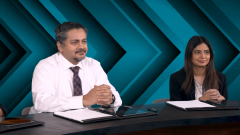
Sequencing Novel Therapies Into Multiple Myeloma Treatment Algorithms
Recommendations regarding best approaches to using novel therapies to treat multiple myeloma based on current drug approvals as well as new therapies in the pipeline.
Episodes in this series

Saad Z. Usmani, MD: We’re winding down to the last few questions that we have. As you’re thinking about treatment options, PI [proteasome inhibitor]–based vs IMiD [immunomodulatory imide drug]–based options, if this patient had discontinued maintenance after a year for whatever reason and they’ve been off treatment for a year, would you still think about going back to an IMiD-based option? How would you distinguish this? There are no clinical trial data. What would influence your decision-making?
Sham Mailankody, MD: I’d probably still favor a non-IMiD regimen in somebody who had relapsed within 1 or 1½ years of stopping treatment, because, on average, you’d expect a somewhat longer remission duration with transplant plus or minus maintenance from old data. Within 1 year of maintenance, in a patient with stringent complete response MRD [minimal residual disease] negativity, you have the disease coming back within a year without any maintenance. That’s concerning to me. It doesn’t mean that this patient cannot go back to IMiDs or lenalidomide [Revlimid] or try different combinations in the future. But as the first step, unless there were compelling reasons to not choose them, I would go with a proteasome inhibitor and a CD38 combo.
Saad Z. Usmani, MD: Do you feel differently?
Neha Korde, MD: No. I like that answer.
Saad Z. Usmani, MD: That’s perfect. I have a question that that we don’t have an answer for, but I want to get a feel from you guys. We’ve talked about how commonly we’re going to be using daratumumab in the frontline setting for our patients, and whether it’s safe for transplant-eligible patients. We haven’t decided whether we’re going to continue it in maintenance for transplant-eligible patients, but the thought is that we probably will for a defined duration of time for certain patients. Then for transplant-ineligible patients, we talked about the MAIA study data being super-impressive. We’re using those data to treat our patients, and then many of those patients are going to continue daratumumab as part of continuous therapy, like in the MAIA study.
With that in mind, how do you think the landscape will change, and choices will change, when patients are coming in for the first relapse? If you have someone who is refractory to anti-CD38, what would our choices be? Instead of lenalidomide maintenance, what if this patient was on daratumumab-lenalidomide maintenance?
Neha Korde, MD: This is where we really need trials, right? This is where we see the different combos moving to the front and things getting shuffled a little. Clearly, as BCMAs are progressing nicely with clinical trials, hopefully we’ll be able to fill in some of those questions and gaps with either CAR [chimeric antigen receptor] T cells or bispecifics. Especially with those new targets, this is where we’ll probably see some more data as the anti-CD38s move to the front line.
Urvi Shah, MD: I definitely agree. In terms of standard-of-care options, Cytoxan [cyclophosphamide] is a good option when combining it with carfilzomib [Kyprolis] if they had daratumumab–RVd [lenalidomide, bortezomib, dexamethasone] in the beginning, or pomalidomide [Pomalyst] with Cytoxan. Some of these drugs could be used.
Saad Z. Usmani, MD: Even some of the newer, smaller molecules, right?
Urvi Shah, MD: Yeah.
Saad Z. Usmani, MD: We’ve got iberdomide, and we’ve got CC-480 coming down the pike. Some other options coming down the pike may become possibilities as well. We’ve kept coming back to the MRD-negativity piece. If you have sustained MRD negativity as an end point where you’re stopping treatment, you’ll have patients who get a fairly reasonable drug-free interval. Those patients are exposed to those classes of drugs, but aren’t going to be refractory. You can potentially recycle some of those mechanisms of actions too.
Sham Mailankody, MD: Along those lines, if you look at all the studies we’ve talked about, the control arms of the studies with 3-drug combinations, at 3 years for something like the GRIFFIN study, 80% and more of patients—even with just RVd [lenalidomide, bortezomib, dexamethasone] and 2 years of maintenance—are progression-free. The scenario that we just talked about, fortunately, is not very common because of the progress we’ve made with treatments. Obviously, we remember our patients who fit this category, whether they’re on quadruplets or doublets, and then relapse in 6 to 12 months. But the good news with myeloma, regardless of which effective treatment you choose, is that the overwhelming majority can go 3 to 4 years without progression of disease.
Transcript edited for clarity.
Newsletter
Stay up to date on recent advances in the multidisciplinary approach to cancer.

















































































